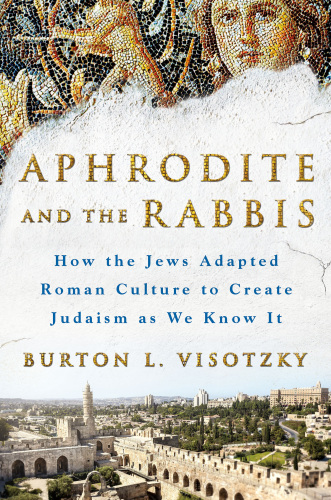
Aphrodite and the Rabbis
How the Jews Adapted Roman Culture to Create Judaism as We Know It
کتاب های مرتبط
- اطلاعات
- نقد و بررسی
- دیدگاه کاربران
نقد و بررسی

July 11, 2016
“There is overwhelming evidence that Judaism took root in Roman soil, imbibed its nourishment, and grafted the good and pruned the bad from the Roman Empire, until a vibrant new religion—Judaism—arose from the wreckage of Israelite religion and the Temple cult, nurtured by the very empire that had destroyed it.” That’s the eye-opening contention of Jewish Theological Seminary professor Visotzky, who does a superior job of making his scholarship easy for a popular audience to digest in this witty and insightful synthesis that will convince most open-minded readers. Even those with some familiarity with the history of Jewish life under Roman rule will be surprised at how many methods of the Roman world—“proverbs, rhetoric, fables, interpretation, symposia, narratives”—were coopted by the rabbis to preserve and enhance their religion in the wake of the destruction of the Second Temple in Jerusalem. Visotzky ends by noting the relevance of his discoveries for contemporary Judaism, arguing that the role of Roman culture in forming the post-temple religion validates the current use of Western methods and traditions to keep the religion alive and flourishing.

May 15, 2016
An exploration of the effects of Roman-era culture on Judaism. Visotzky (Midrash and Interreligious Studies/Jewish Theological Seminary; Sage Tales: Wisdom and Wonder from the Rabbis of the Talmud, 2011, etc.) convincingly argues that, from C.E. 70 onward, Judaism was greatly influenced by the Roman culture surrounding it. He is less successful in tying that history to Judaism as experienced today. It is widely understood that with the first-century destruction of the Temple in Jerusalem, Judaism transformed into a Scripture-based, synagogue-centered religion. The author asserts that Roman culture had a far greater bearing on the formation of this renewed Judaism than most experts believe. He couches much of his thesis in the intriguing fact that the Jews of the time saw the Romans as the children of Esau, twin brother to Jacob, the father of the Israelites. Therefore, to the Jews, the Romans were at once siblings and enemies. "It strikes me that in this choice of Esau as the symbol of Rome," writes Visotzky, "the rabbis gave voice to the complexity of their relationship." What Judaism borrowed from Rome seems mainly to have been aspects of learned or upper-class lifestyles. For instance, the author notes that the rabbis learned the art and value of rhetoric from the Romans, and they used the teachings of philosophical schools, such as the Stoics and the writings of Plato. They also adopted Roman architecture, as seen in early synagogues, and Roman art. The competition among Latin, Greek, and Hebrew is another important piece of the author's discussion. Visotzky spends less effort in finding ways in which Roman culture touched working-class Jews or how it still resonates in modern Judaism. However, his personal exploration of Jewish catacombs does provide a touching example of how all Jews in the Roman Empire were touched by Roman culture and language. Plus, his theory that the modern Seder is a product of the Roman Symposium is certainly food for thought. An intriguing, though perhaps incomplete, look at two cultures colliding and coexisting.
COPYRIGHT(2016) Kirkus Reviews, ALL RIGHTS RESERVED.

July 1, 2016
The Roman Empire fostered two lasting religious movements. One usurped it institutionally. The other, rabbinic Judaism, absorbed its culture much more fully than most realize. Visotsky reveals how fully primarily by comparing rabbinic Jewish wisdom stories and their classical analogues. Roles, motifs, and even names were transferred directly from Roman to Jewish parables. Preeminent non-Jews, such as Alexander the Great and several Roman emperors, were incorporated into Jewish stories. Jewish funerary art came to resemble that of Roman cemeteries with their walled gardens and commemorative pictures and sculpture. Jewish education adopted the study and practice of classical rhetoric, the argumentative performance art deemed essential to public service by Rome and Greece before it. Arguably the most important change was the reorientation of Judaism away from the sacrificial cult of the great temple in Jerusalem and toward the intense study of the Torah in the manner of classical philosophy; priests yielded to teachers. An erudite, pertinently illustrated, and accessible work of religious history.(Reprinted with permission of Booklist, copyright 2016, American Library Association.)

























دیدگاه کاربران